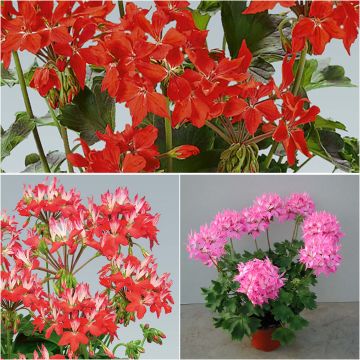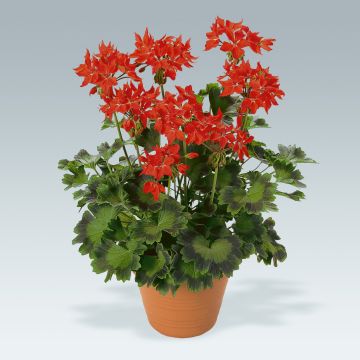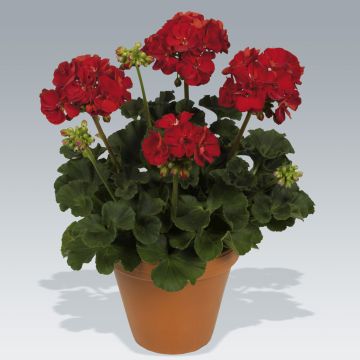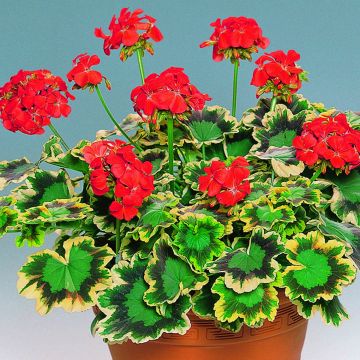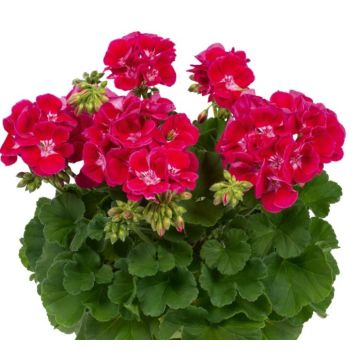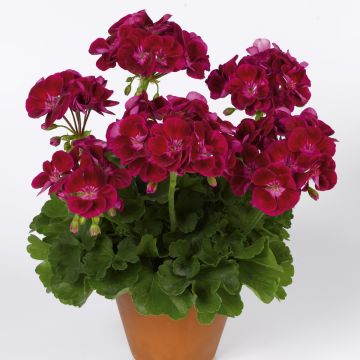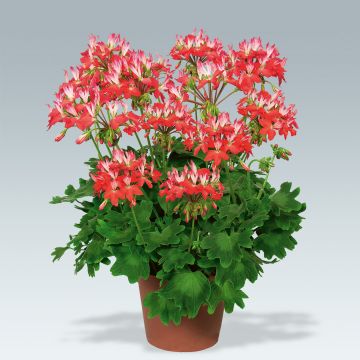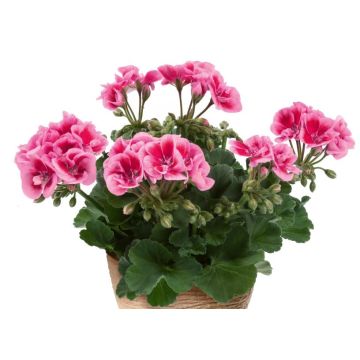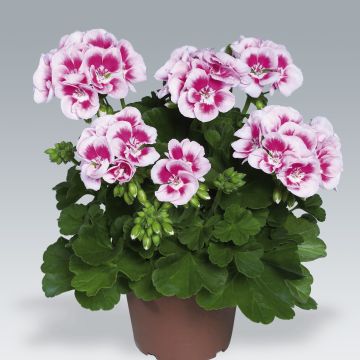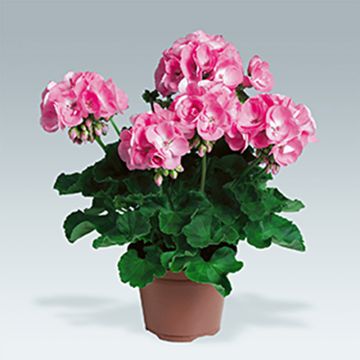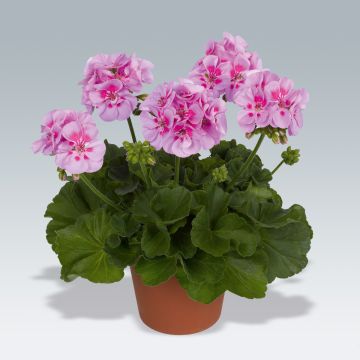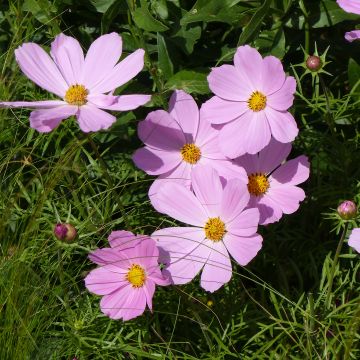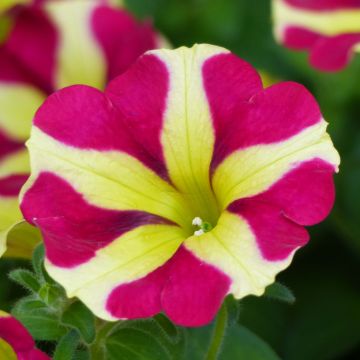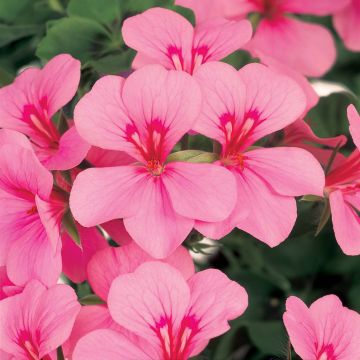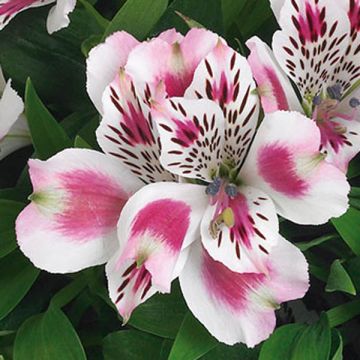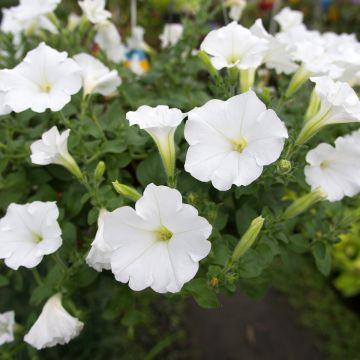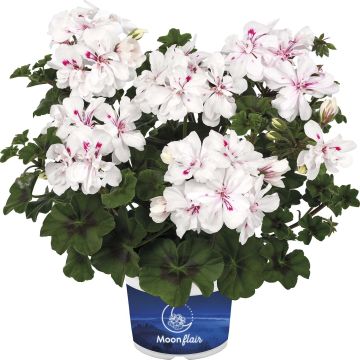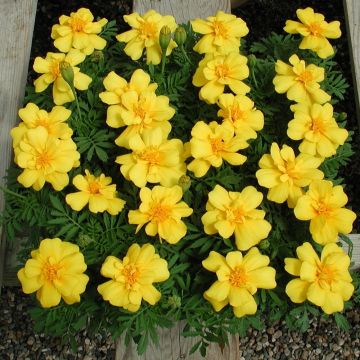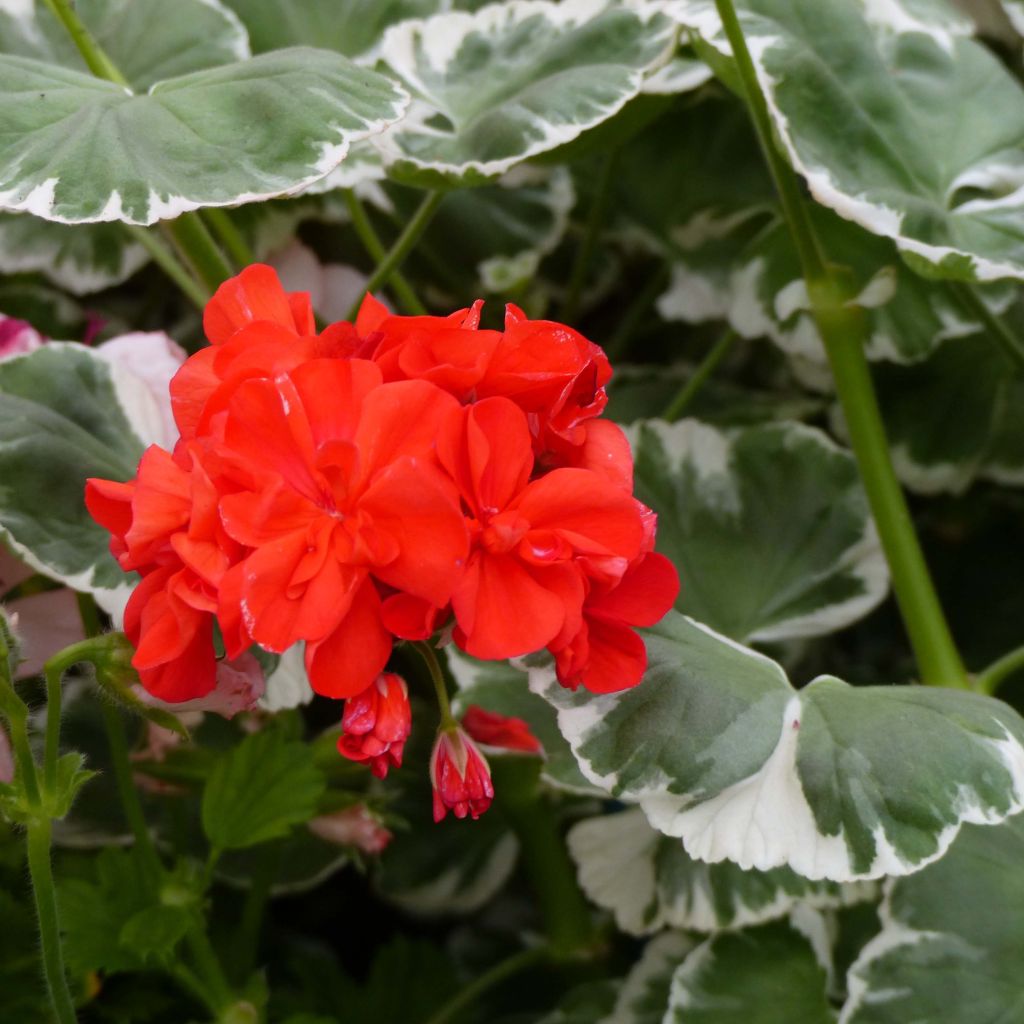

Pelargonium Wilhelm Langguth
Pelargonium Wilhelm Langguth
Pelargonium x hortorum Fantaisy Wilhelm Langguth
Zonal geranium, Garden geranium
Why not try an alternative variety in stock?
View all →This plant carries a 6 months recovery warranty
More information
We guarantee the quality of our plants for a full growing cycle, and will replace at our expense any plant that fails to recover under normal climatic and planting conditions.
From €5.90 for pickup delivery and €6.90 for home delivery
Express home delivery from €8.90.
Delivery to Corse prohibited: UE law prohibits the import of this plant from mainland France to Corse as part of the fight against Xylella fastidiosa. Please accept our sincere apologies.
More information
Does this plant fit my garden?
Set up your Plantfit profile →
Description
Pelargonium 'Wilhelm Langguth' is a variety of zonal geranium with decorative foliage and a well-branched upright habit. It bears round heads of bright red flowers on sturdy stems, against beautiful variegated foliage of soft grey-green and white, which is attractive all year round. It blooms from spring to autumn, forming vibrant and healthy bushes. It can be grown as a standalone plant to capture its beauty or mixed with other varieties. Its flowers are particularly beautiful in bouquets.
Zonal pelargoniums are perennial hybrids of the Geraniaceae family, known as Pelargonium x hortorum. They are mostly derived from P. inquinans, native to the southeastern tip of Africa, with contributions from P. zonale and P. frutetorum. 'Wilhelm Langguth' is part of a series of hybrids with decorative foliage that has gained renewed interest in recent years. It forms a bushy clump with a very upright habit and vigorous growth, reaching a height of 60cm (24in) and a diameter of 40cm (16in). It flowers from spring to autumn, producing consistently bright, single, slightly fragrant flowers in round clusters. The flowers are a light, scarlet red, contrasting perfectly with velvety, soft grey-green leaves marked with a darker central zone and bordered with cream-white. Its sturdy and succulent stems bear almost perfect circular leaves, with slightly toothed edges and a thick texture. The foliage is very healthy.
Once reserved for balconies and patios, pelargoniums have made a notable entrance into sunny flower beds and borders. Plant them en masse to create a lasting and cheerful display throughout summer. These plants tolerate drought fairly well, making them suitable companions for garden verbenas, blue lobelias, and black or purple-leaved morning glories (Ipomoea Illusion Midnight Lace, Ipomoea Sweet Heart 'Purple'). Create magnificent containers and hanging baskets by combining them with vibrant pink or red varieties, Million Bells, variegated periwinkles, Dichondra 'Silver Falls', violets, and calibrachoas.
Please be aware that our young plug plants are professional products intended for experienced gardeners. Upon receipt, repot and store them under cover (veranda, greenhouse, cold frame) at a temperature above 14°C (57.2°F) for a few weeks before planting them outdoors, once the risk of frost has definitely passed.
Report an error about the product description
Pelargonium Wilhelm Langguth in pictures
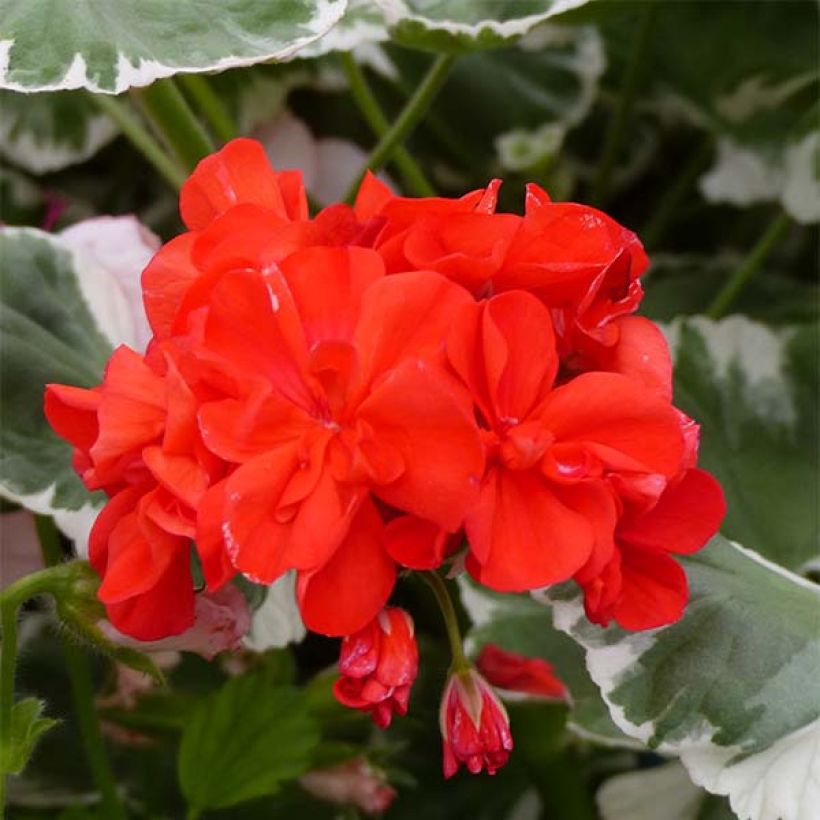

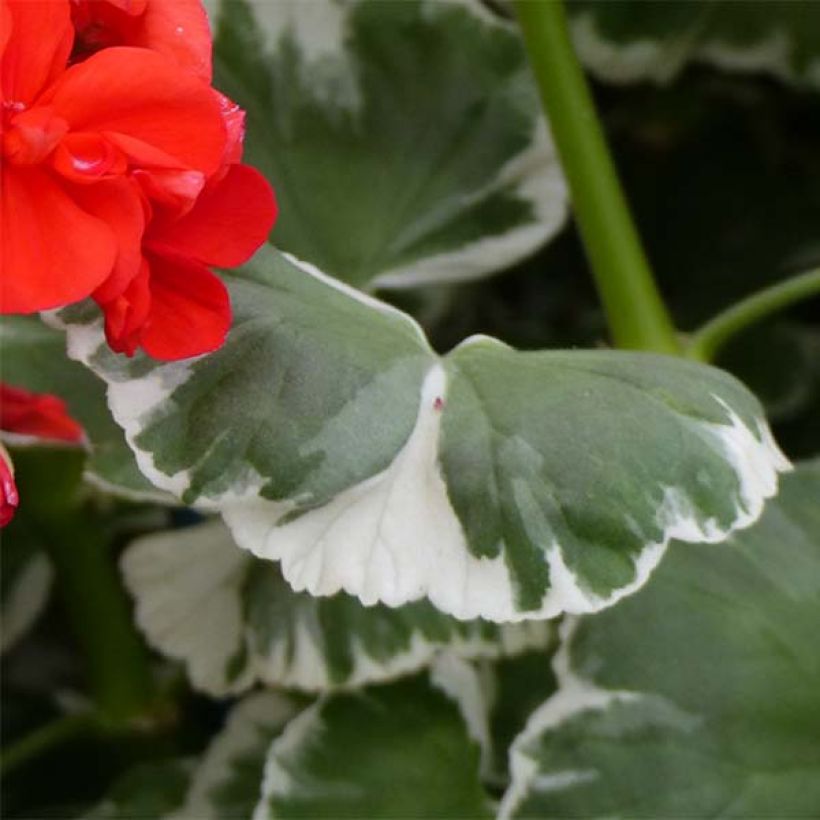

Flowering
Foliage
Plant habit
Botanical data
Pelargonium
x hortorum
Fantaisy Wilhelm Langguth
Geraniaceae
Zonal geranium, Garden geranium
Cultivar or hybrid
Other Zonal Pelargonium
Planting and care
Zonal geraniums thrive in fertile, well-drained, neutral to alkaline, well-loosened soils. They prefer full sun. Geraniums are hungry plants that require regular applications of fertiliser to give their best.
You can plant pelargoniums as early as March-April in mild climate regions, but they will need to be brought indoors in case of frost. To avoid any danger, wait until the risk of frost has passed before placing them outside. When planting in pots or containers, use special geranium compost.
In the garden, wait until the end of April, or even mid-May, to plant them in the ground. Add a special geranium growing support to your soil.
Planting period
Intended location
Care
-
, onOrder confirmed
Reply from on Promesse de fleurs
Plug plants - Annuals
Haven't found what you were looking for?
Hardiness is the lowest winter temperature a plant can endure without suffering serious damage or even dying. However, hardiness is affected by location (a sheltered area, such as a patio), protection (winter cover) and soil type (hardiness is improved by well-drained soil).

Photo Sharing Terms & Conditions
In order to encourage gardeners to interact and share their experiences, Promesse de fleurs offers various media enabling content to be uploaded onto its Site - in particular via the ‘Photo sharing’ module.
The User agrees to refrain from:
- Posting any content that is illegal, prejudicial, insulting, racist, inciteful to hatred, revisionist, contrary to public decency, that infringes on privacy or on the privacy rights of third parties, in particular the publicity rights of persons and goods, intellectual property rights, or the right to privacy.
- Submitting content on behalf of a third party;
- Impersonate the identity of a third party and/or publish any personal information about a third party;
In general, the User undertakes to refrain from any unethical behaviour.
All Content (in particular text, comments, files, images, photos, videos, creative works, etc.), which may be subject to property or intellectual property rights, image or other private rights, shall remain the property of the User, subject to the limited rights granted by the terms of the licence granted by Promesse de fleurs as stated below. Users are at liberty to publish or not to publish such Content on the Site, notably via the ‘Photo Sharing’ facility, and accept that this Content shall be made public and freely accessible, notably on the Internet.
Users further acknowledge, undertake to have ,and guarantee that they hold all necessary rights and permissions to publish such material on the Site, in particular with regard to the legislation in force pertaining to any privacy, property, intellectual property, image, or contractual rights, or rights of any other nature. By publishing such Content on the Site, Users acknowledge accepting full liability as publishers of the Content within the meaning of the law, and grant Promesse de fleurs, free of charge, an inclusive, worldwide licence for the said Content for the entire duration of its publication, including all reproduction, representation, up/downloading, displaying, performing, transmission, and storage rights.
Users also grant permission for their name to be linked to the Content and accept that this link may not always be made available.
By engaging in posting material, Users consent to their Content becoming automatically accessible on the Internet, in particular on other sites and/or blogs and/or web pages of the Promesse de fleurs site, including in particular social pages and the Promesse de fleurs catalogue.
Users may secure the removal of entrusted content free of charge by issuing a simple request via our contact form.
The flowering period indicated on our website applies to countries and regions located in USDA zone 8 (France, the United Kingdom, Ireland, the Netherlands, etc.)
It will vary according to where you live:
- In zones 9 to 10 (Italy, Spain, Greece, etc.), flowering will occur about 2 to 4 weeks earlier.
- In zones 6 to 7 (Germany, Poland, Slovenia, and lower mountainous regions), flowering will be delayed by 2 to 3 weeks.
- In zone 5 (Central Europe, Scandinavia), blooming will be delayed by 3 to 5 weeks.
In temperate climates, pruning of spring-flowering shrubs (forsythia, spireas, etc.) should be done just after flowering.
Pruning of summer-flowering shrubs (Indian Lilac, Perovskia, etc.) can be done in winter or spring.
In cold regions as well as with frost-sensitive plants, avoid pruning too early when severe frosts may still occur.
The planting period indicated on our website applies to countries and regions located in USDA zone 8 (France, United Kingdom, Ireland, Netherlands).
It will vary according to where you live:
- In Mediterranean zones (Marseille, Madrid, Milan, etc.), autumn and winter are the best planting periods.
- In continental zones (Strasbourg, Munich, Vienna, etc.), delay planting by 2 to 3 weeks in spring and bring it forward by 2 to 4 weeks in autumn.
- In mountainous regions (the Alps, Pyrenees, Carpathians, etc.), it is best to plant in late spring (May-June) or late summer (August-September).
The harvesting period indicated on our website applies to countries and regions in USDA zone 8 (France, England, Ireland, the Netherlands).
In colder areas (Scandinavia, Poland, Austria...) fruit and vegetable harvests are likely to be delayed by 3-4 weeks.
In warmer areas (Italy, Spain, Greece, etc.), harvesting will probably take place earlier, depending on weather conditions.
The sowing periods indicated on our website apply to countries and regions within USDA Zone 8 (France, UK, Ireland, Netherlands).
In colder areas (Scandinavia, Poland, Austria...), delay any outdoor sowing by 3-4 weeks, or sow under glass.
In warmer climes (Italy, Spain, Greece, etc.), bring outdoor sowing forward by a few weeks.


































